Moses
Moses Modibedi had a feeling it was going to be his lucky day.
That January morning he left his ramshackle plastic-covered shanty on the outskirts of Kimberley for another shift toiling in the diamond waste fields. As he began work, just after 8am, he shovelled some gravel left over from the previous day on to a self-made wire-mesh sieve. He was about to pick it up when something in the rubble caught his eye.
“It was a 21-carat. But I can’t tell you how much I made [from selling it],” he says with a chuckle.
When he came to the diamond fields to start work as a zama-zama, the term given to artisanal miners, he had only a single bed, some cutlery, wooden poles, sheets and plastic bags to set up a shack in Samaria, a shantytown that’s home to hundreds of artisanal miners near Kimberley.
Modibedi had been working as a driver on a diamond mine, earning R1 700 a month. He could hardly make ends meet, especially because he had to support unemployed siblings and an extended family. Fed up, he quit and headed for Kimberley, where he had heard through the bush telegraph that men and women were making good money as their own bosses digging for diamonds.
For two months he sweated, seven days a week, without any luck, returning to his shanty dispirited but determined not to give up. Back home in Taung, worried family members would scramble around for money and send him just enough to buy bread.
His beat-up bakkie helped to bring in some money, ferrying goods for fellow miners.
But the diamond, a fruit from Mother Earth, put a shine into his life. Now he drives a second-hand Toyota SUV that one would struggle to find even in a middle-class suburb. He has renovated his family home in Taung. The plastic-covered shack he called home for years has been upgraded into a spacious wooden home.
Two weeks after selling the diamond on the black market, he was back in Samaria, digging and sifting through the ground in search of another.
“You never know when you are going to get another one. It’s like gambling. [It’s] win or lose,” he says, pouring a mound of earth into a bucket.
Next to him his two assistants, Gilbert Sehumi and Abednigo Piet, are hard at work. Dust rises and sand drops at their feet as they push a 1.5m sieve to and fro.
People are scattered all around and way beyond them on the flat land, consumed by the same task. Using picks, shovels, plastic buckets and sieves, they work quietly, with deep frowns, meticulously sifting through piles of soil in search of the shiny stone that could be their passport out of this hard life.
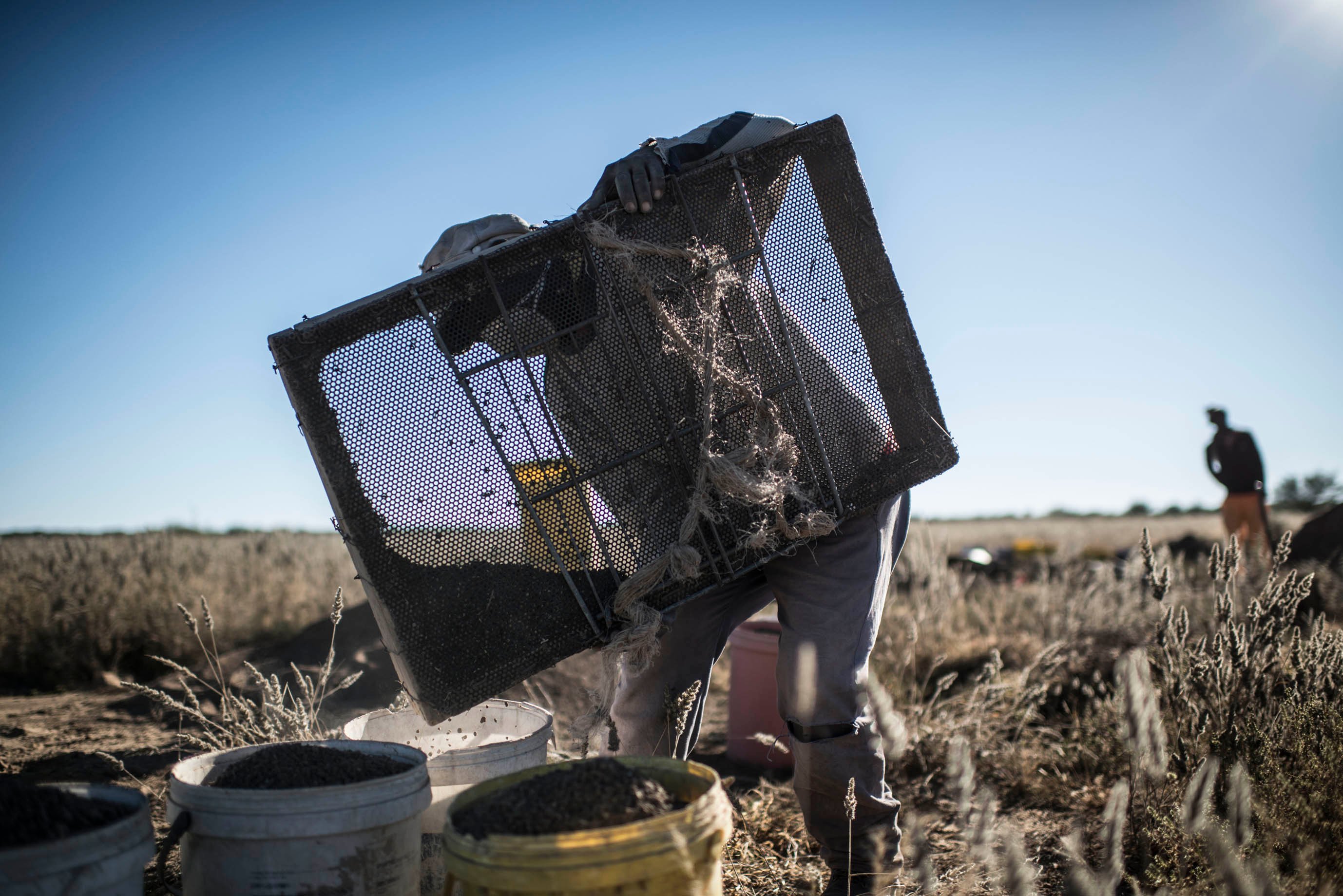
[One of the thousands of artisanal diamond miners sifts through De Beers’ tailings in the veld outside Kimberley. (Paul Botes/M&G)]
There are about 3 000 artisanal miners, both men and women, scratching out a living on the land that used to be residual dumping sites for the diamond mining conglomerate De Beers. They come from as far afield as Lesotho, the Free State, Mpumalanga, KwaZulu-Natal, North West, Zimbabwe and Mozambique, and from the Northern Cape itself.
Kimberley became the heart of Southern Africa’s diamond mining from about 1869, when fortune seekers by their thousands descended on the village on the edges of the Kgalagadi desert. In time, colonial invaders such as Barney Barnato and Cecil John Rhodes became powerful diamond-mining magnates by hook, crook and cunning.
It is believed that small-scale mining by the Griqua, Nama, Batlhaping and other African groups predates the diamond rush.
The legacy of men like Barnato and Rhodes and the formation of De Beers is still being felt by the indigenous people, who were reduced to bit players in the mineral wealth of their motherland.
Modibedi and his comrades, who are organised under the Batho Pele and Goedemoed Mining co-operatives, are part of a new generation shaking the foundations of dominance by colonial establishments. The two co-operatives make up the Northern Cape Artisanal Miners’ Association, which is on a mission to formalise and regulate the miners’ activities.
Lucky Seekoei, the chairperson of the association, says they are mining on 35 hectares divided into five pockets of land. De Beers’ dumping ground for residue from its mining operations was more recently sold to Ekapa Mining.
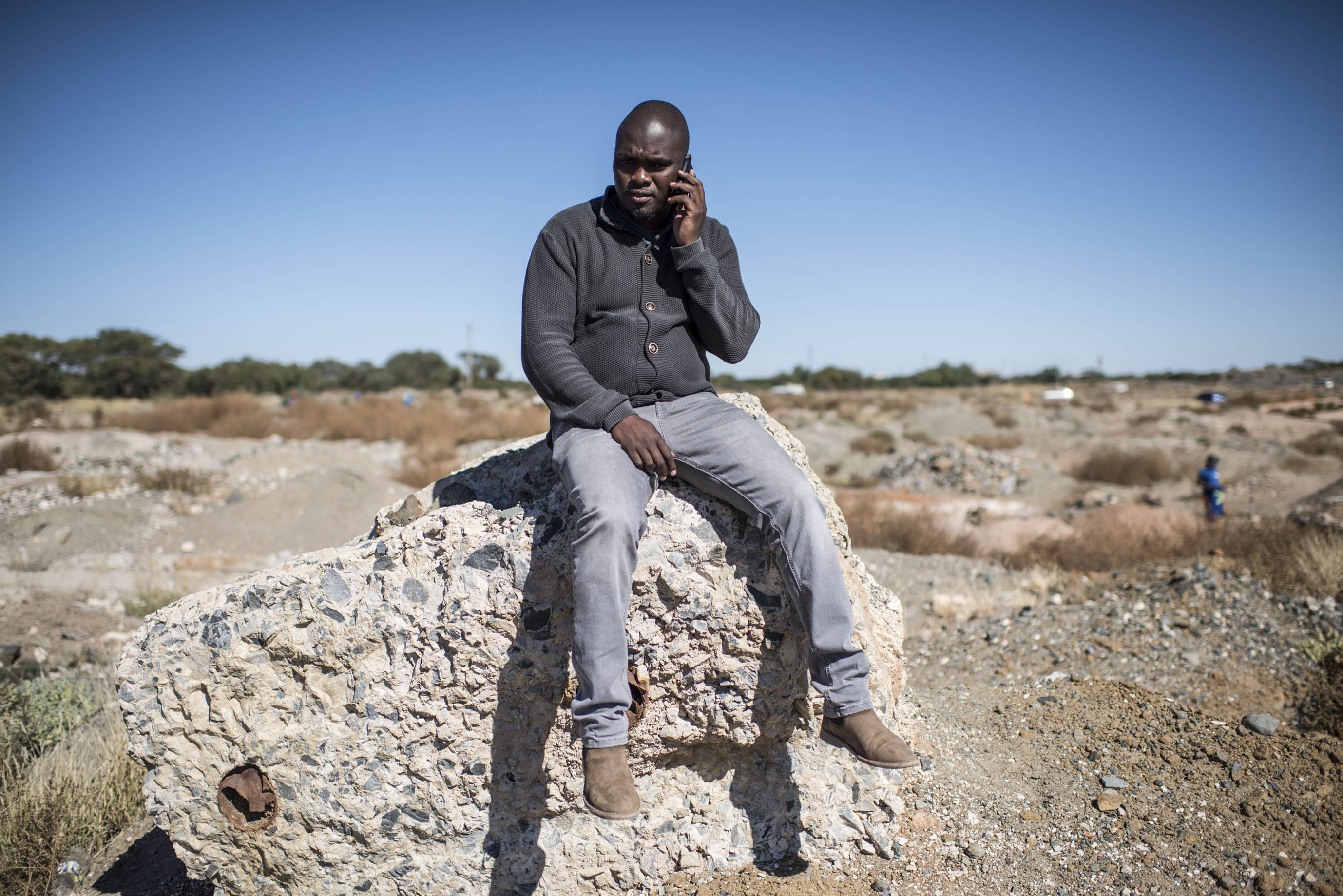
[Lucky Seekoei heads the Northern Cape Artisanal Miners’ Association, which is pushing for the recognition of informal miners. (Paul Botes/M&G)]
For the better part of the past decade, mine security and police had running battles with the endless stream of zama-zamas to keep them out. Seekoei, himself a former zama-zama, says during that period more than 50 people were arrested for offences ranging from trespassing to public violence.
But the threat of jail time and hefty fines did not deter the zama-zamas — with dependents waiting in poverty-stricken villages and townships, they stuck it out.
“People are trying to make a living,” says Seekoei, standing on an elevated mound of soil at one of the sites, which the diggers call Beefmaster. “All the minerals from the land helped to change their lives,” he says, referring to almost a dozen cars, including what appears to be a brand-new double cab, parked in the fields.
He says the association plans to register all the zama-zamas operating in the diamond fields and to ensure they have mining permits, which will allow them to trade on the open market. They are given a raw deal on the black market.
They also want to introduce medical aid and a pension fund, and to register individual miners with the South African Revenue Services so that they can pay tax. To be part of the co-operative, zama-zamas pay a R100 administration fee and hand in a certified copy of their identity document.
“We want to stop this thing of people hiding their money under mattresses. They must be able to bank their money without fear [of the authorities],” says Seekoei.
Last month, the department of mineral resources agreed to issue Batho Pele and Goedemoed with small-scale mining permits. This has set the zama-zamas in the Northern Cape on a path towards normalising their activities.
Instead of fleeing in fear when they spot a mine security patrol, they now wave and exchange pleasantries with the men in the armoured cars. Mine security guards, as part of a deal with the co-operatives, work hand in hand with committees from the mining fields to maintain peace and order.
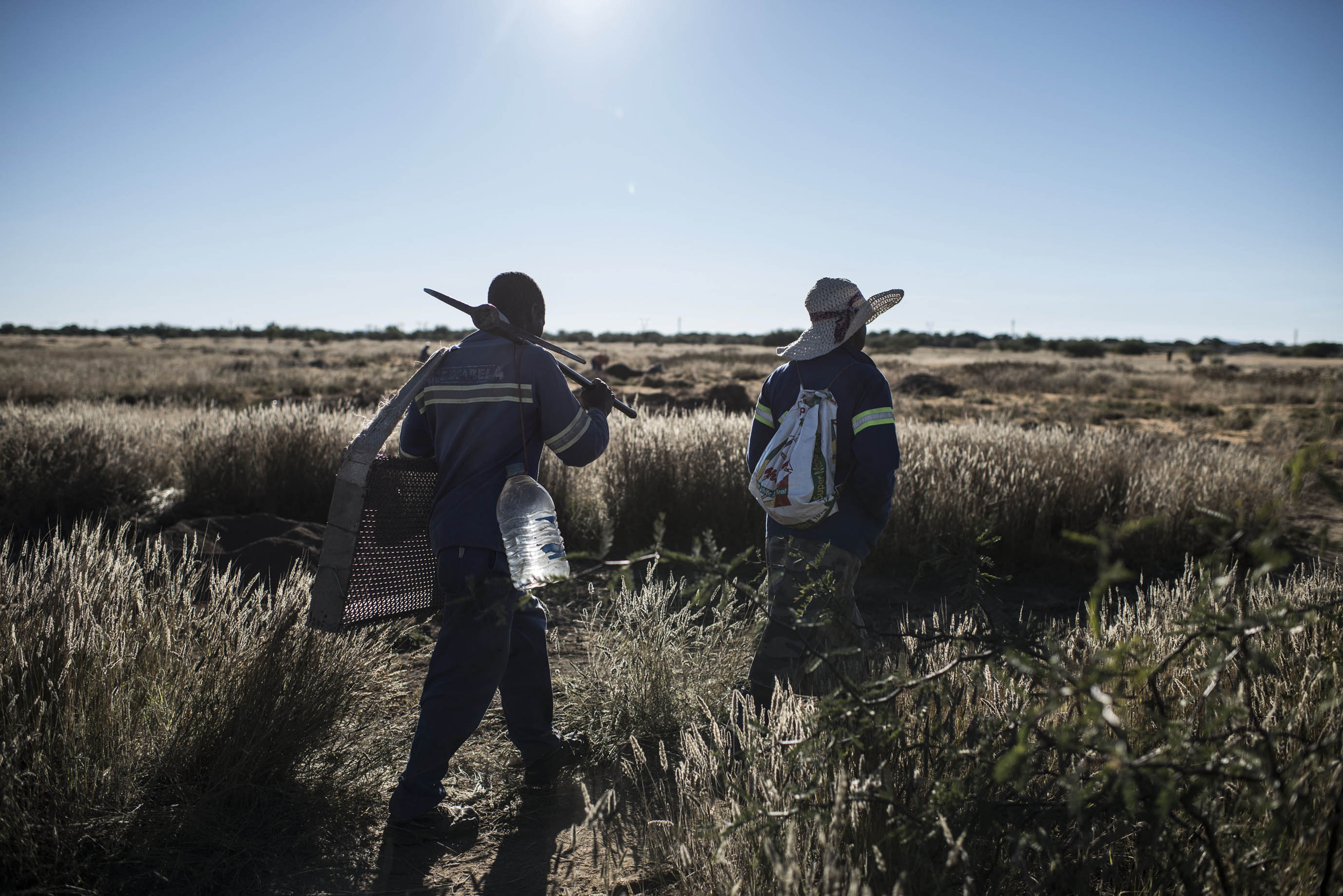
[Each morning miners in groups of two or three set out to find diamonds. Security guards and police used to chase the zama-zamas but now the artisanal miners are registering (left) with co-operatives and associations to get recognition. (Paul Botes/M&G)]
But this remains a hard life. On a slightly chilly winter’s morning, men and women emerge from shanties to relieve themselves and brush their teeth in preparation for another day of toil. The shanties are built of poles, cardboard and pieces of old furniture covered with black plastic refuse bags tied together with wire and string.
Others, like Modibedi, check on their cars, bakkies, shiny and not so shiny sedans parked close to the shacks.
Some of the residents are already warming themselves around open wood fires. Kettles of water and pots of pap are cooking.
Men in boots and overalls prepare the tools of their trade — sieves, shovels, picks and buckets. Others stand soaking up the sun, sipping on cups of tea or coffee.
Samaria is within walking distance of the five areas being mined by the zama-zamas. It is a temporary village, with one communal tap. There’s no electricity. Every concealed space serves as an open toilet. Walking around in the dark without a torch poses the risk of slipping in excrement. Cellphones are charged with tiny solar panels that are left in the sun as soon as the first rays kiss the land.
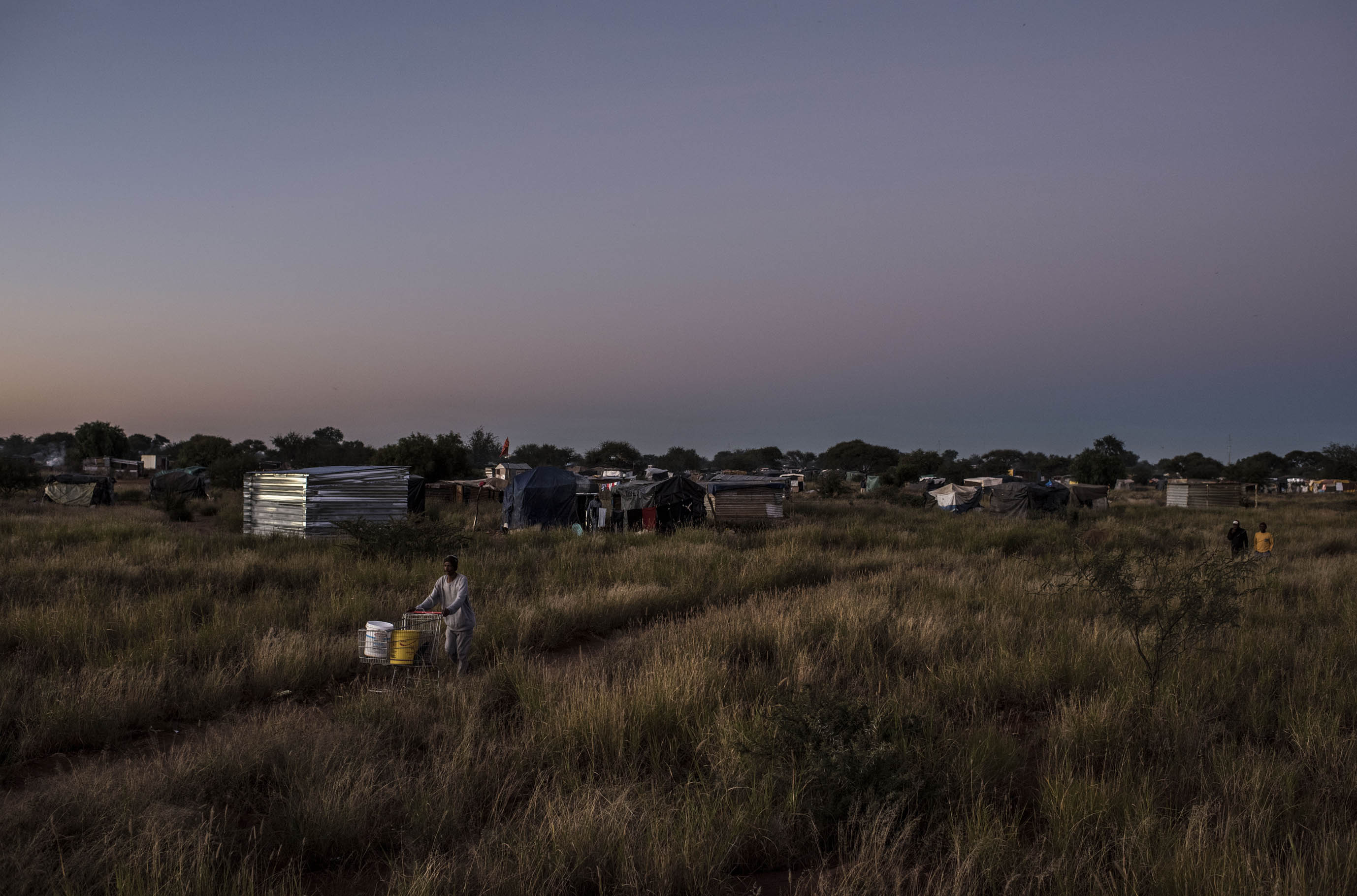
[The diamond diggers live in Samaria, a shanty settlement of temporary wood and plastic homes. (Paul Botes/M&G)]
Kedibone Jacobs lives in one of these shacks with friend and fellow miner Precious Mogale. She came to Samaria from Warrenton, 70km north of Kimberley, in October last year after being jobless for six years. Her uncle was working in the diamond fields and living in Samaria. She first lived with him in a shack divided into two rooms before setting up her own.
She toiled for eight long months without finding a diamond, which is common. Many zama-zamas leave the hard life of artisanal mining.
At the beginning of May, she made R3 000 after unearthing an 80-point stone. (There are 100 points in a carat). Money from sales is shared among those in the teams of zama-zamas, usually two to three people, who share the digging and sifting.
Many of the zama-zamas are independent, proud people who scorn the idea of living on state welfare. “They must help us with electricity and toilets, then leave us alone to work,” says Jacobs.
Daisy Damons is one of the veterans of the trade. She walks with difficulty after injuring her spine in a road accident. Both her parents were licensed small-scale diamond miners and even owned a mine, which they were forced to sell for R18 000 in the 1970s.
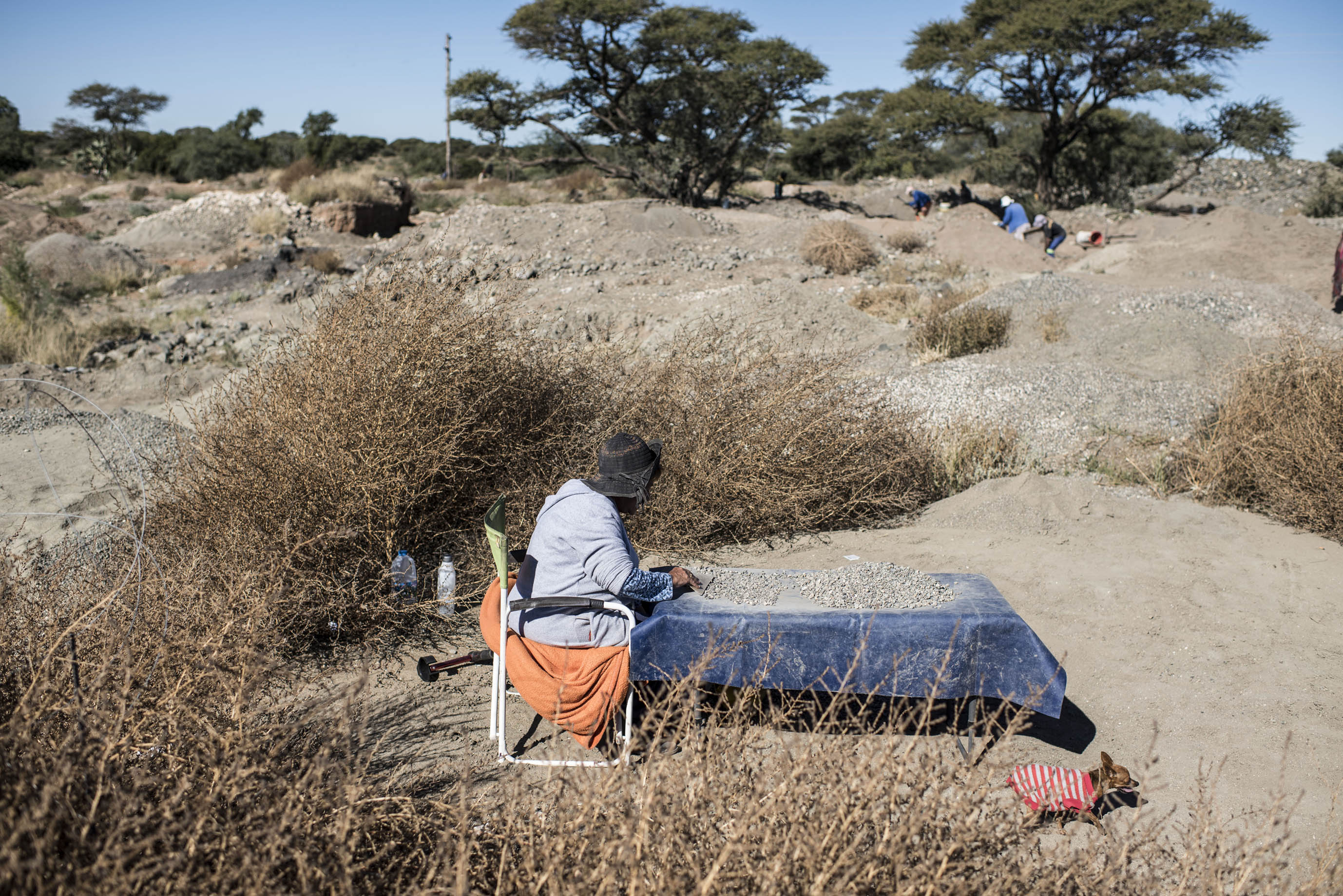
[Daisy Damons has been searching for diamonds — God’s tears as she calls them — for most of her life. (Paul Botes/M&G)]
She has been involved in the trade since her teens. A succession of incidents, bad business deals and a divorce took a toll on her finances.
But she has remained in mining and, in 1999, served as chairperson of the South African Women in Mining Association pioneered by former deputy president Phumzile Mlambo-Ngcuka. Now she spends her days sitting on a chair searching for diamonds in the rubble dug up by her son and daughter-in-law.
“I’m doing it for survival. It is no longer something I do for love,” she says.
The family has had no luck this year. The last time they found a stone was in August last year, when they unearthed a 3.5-carat diamond, which they sold for R9 000 on the black market. Damons says it would have gone for R35 000 on the formal market.
Although she does not believe in expropriating agricultural land without compensation, Damons says this policy should apply to mining houses such as De Beers and their land should be distributed to artisanal miners.
“You must know diamonds. I call them tears of God. If you are lucky and you get a really good one, it can change your life,” she says.
Damons says the government should relax some of its regulations to help artisanal miners to get individual small-scale mining permits. These would include doing away with consultants and difficult bank guarantees that are out of the reach of many miners.
“We are not asking them to spoon-feed us,” she says.
Lebogang Shomoleile came to Kimberley to look for a job after he was retrenched from a diamond mine. But, when he learned about the diggers of Samaria and how his life could change if he joined them, he went there.
Since then, he says he has made at least R200 000 from digging and selling diamonds.
“I could have made more money if we had permits,” he sighs.
Prices on the black market are a fraction of what the diggers could make on the formal market. A one-carat diamond in good condition fetches about R3 500 on the black market when it could fetch between R60 000 and R70 000 on the formal market.
Although the Samaria community is closely knit and stealing is frowned upon, there’s an unwritten rule to sell a stone as quickly as possible to avoid it being stolen — or lost.
Samuel Tlhole has been living on the edge as an unregistered artisanal miner since 1980, traversing the Northern Cape in search of a good stone.
“We are not stealing from anyone,” says Samuel, who now lives in Samaria with his brother, Reginald.
He has lost count of how many times he has had to flee from the authorities and how many times he has been swindled by dealers taking advantage of the fact that he didn’t have a permit.
“I have been chased with helicopters, horses. They [police and mine security] were looking for permits. My brother was arrested. Then he asked the police: ‘Show me anyone who brought diamonds to this world when they were born?’ They beat him up,” he says.
A stocky, muscular man with a greyish sprinkling of beard, he says the big diamond mining companies that exist today grew from artisanal mining and, as such, people like
him should be allowed to make their living off the land harvesting diamonds.
“They come from God. Diamonds come from God. Nobody should stop another from making a living from them,” he says. — Mukurukuru Media